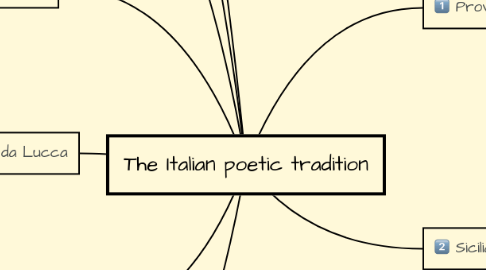The Italian poetic tradition
by Ellie Harding


1. Tuscan imitators
1.1. Upsurge in trade led to the concentration of a variety of languages in one area - the Magna Curia began to be reproduced with a multitude of influences in Tuscany and Romagna.
1.2. First group of imitators were Siculo-Tuscans
1.3. Second group of imitators were fully fledged Tuscans
2. Guittone d'Arezzo
2.1. Poetry heavily influenced by Sicilian and Provencal
2.1.1. Strong troubadour influences
2.1.2. Favourite metric form was the Sicilian sonnet
2.2. Wanted to raise the intellectual status of the vernacular
2.3. Religious themes
2.4. Letters written in the vernacular
3. Bonagiunta da Lucca
3.1. Strongly influenced by the troubadours of Provence
3.1.1. Injected this influence into his works written in the Vernacular
3.2. Also proficient in Latin
4. Guido Guinizzelli (1230-1276)
4.1. First poet to write in the 'modern usage'
4.2. Sonnets! Abundant use of visual images
4.3. Wrote predominantly in the vernacular, though with french and provencal influences.
4.4. Dante called Guinizzelli his 'father'
5. Guido Cavalcanti (1259-1300)
5.1. Verses almost exclusively about love
5.1.1. Love is an accidental, irrational event of the senses
5.2. Sensitive as opposed to rational soul
5.3. Dante's 'first friend'
6. Cino da Pistoia (1265-1337)
6.1. Salvaged the reputation of the Italian Vernacular in the face of French and Provencal
6.2. Influenced Petrarch and Boccaccio
7. Stilnovo
7.1. Poets predominantly from upper middle-class, Florentine backgrounds
7.2. Shift from love as a verb (the lover) to love as a noun (love itself)
8. Provencal influence
8.1. Riambautz de Vaqueiras (1180-1207) Wrote in Provencal, Italian dialect, French, Gascon and Galician.
8.2. Lambertino Buvalelli (d. 1221) Composed solely in Provencal, probably learned it from reading circulating works rather than direct contact.
8.3. Lanfranco Cigala (d.1278) Sordello da Goito (d.1260_
9. Sicilian school
9.1. First generation of Sicilian poets started writing 1230.
9.1.1. Sicilian poetry translated by tuscans is heavily tuscanised; Sicilian has 5 tonic vowels whereas Tuscan has 7.
9.1.2. Translation across dialects didn't tend to have the same poetic impact as the original.

